Family Involvement in Resuscitation: Literature Review - UTS
VerifiedAdded on 2023/06/13
|7
|2072
|206
Literature Review
AI Summary
This literature review examines the role of family members during the resuscitation of loved ones in acute care settings, drawing on research from The National Centre for Biotechnology Information. It explores the approaches nurses use when dealing with family members in these critical situations, referencing nursing theories and models. The review analyzes studies focusing on the impact of family presence on resuscitation outcomes, staff attitudes, and psychological effects. Key findings suggest that involving family members can offer psychological benefits to both patients and their families, reducing grief and PTSD symptoms. The review emphasizes the importance of healthcare facilities developing clear policies and providing support to families during resuscitation to maximize positive outcomes and minimize potential harm. The study concludes that while some concerns exist regarding potential delays or psychological harm, the overall benefits of family presence outweigh the risks, advocating for individualized, facility-specific policies to guide family involvement in the resuscitation process. Desklib provides access to similar solved assignments and study resources for students.
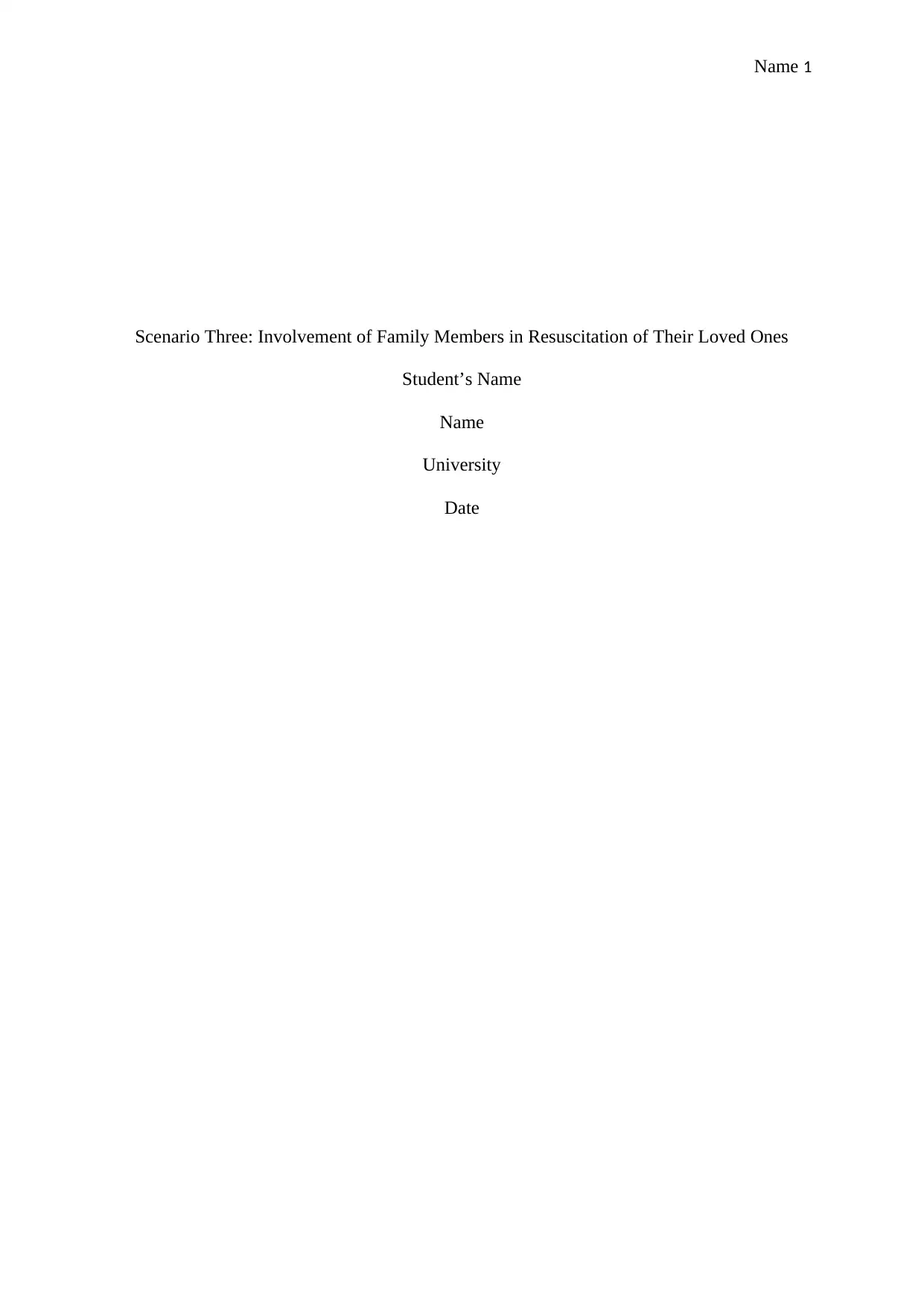
Name 1
Scenario Three: Involvement of Family Members in Resuscitation of Their Loved Ones
Student’s Name
Name
University
Date
Scenario Three: Involvement of Family Members in Resuscitation of Their Loved Ones
Student’s Name
Name
University
Date
Paraphrase This Document
Need a fresh take? Get an instant paraphrase of this document with our AI Paraphraser
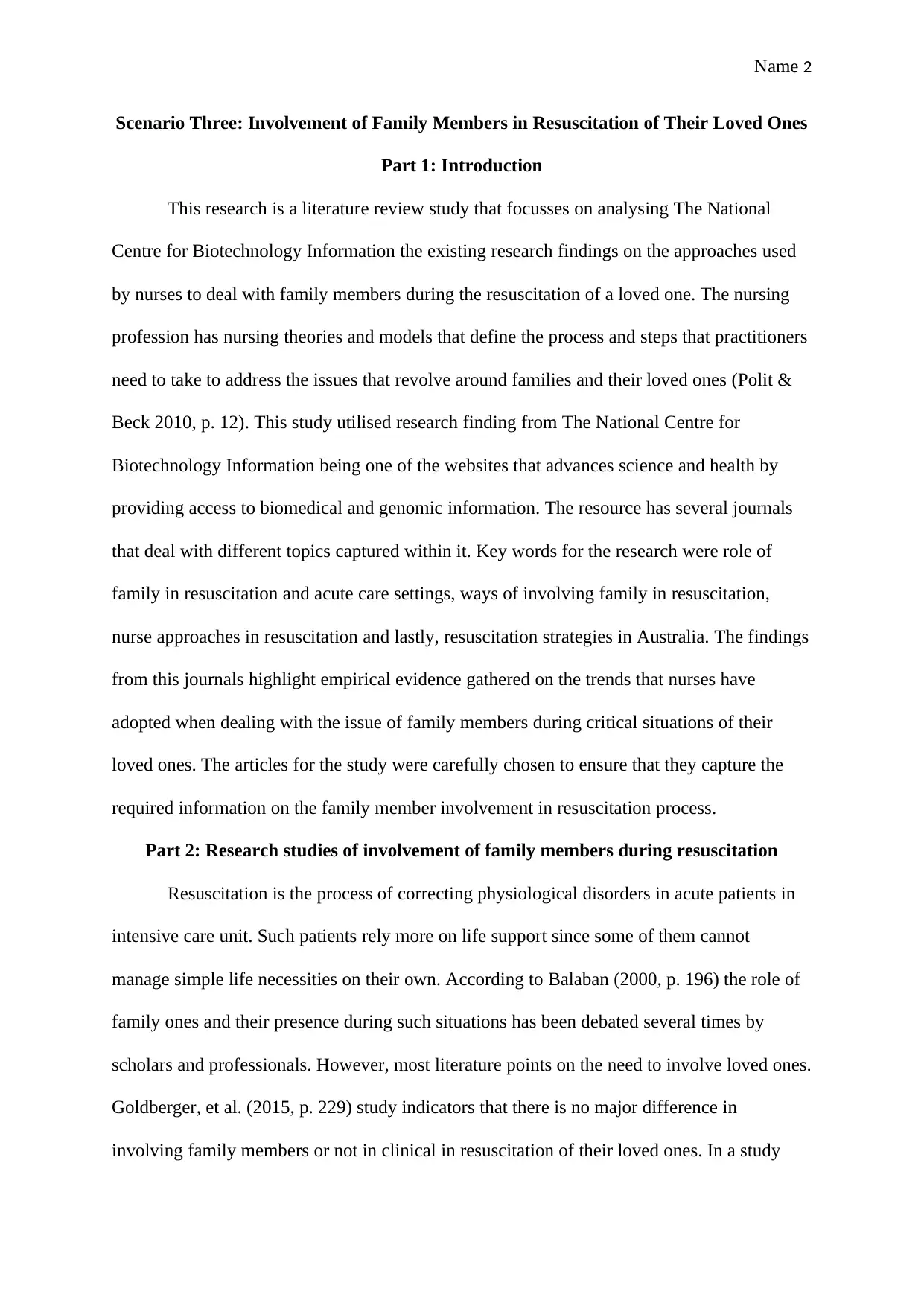
Name 2
Scenario Three: Involvement of Family Members in Resuscitation of Their Loved Ones
Part 1: Introduction
This research is a literature review study that focusses on analysing The National
Centre for Biotechnology Information the existing research findings on the approaches used
by nurses to deal with family members during the resuscitation of a loved one. The nursing
profession has nursing theories and models that define the process and steps that practitioners
need to take to address the issues that revolve around families and their loved ones (Polit &
Beck 2010, p. 12). This study utilised research finding from The National Centre for
Biotechnology Information being one of the websites that advances science and health by
providing access to biomedical and genomic information. The resource has several journals
that deal with different topics captured within it. Key words for the research were role of
family in resuscitation and acute care settings, ways of involving family in resuscitation,
nurse approaches in resuscitation and lastly, resuscitation strategies in Australia. The findings
from this journals highlight empirical evidence gathered on the trends that nurses have
adopted when dealing with the issue of family members during critical situations of their
loved ones. The articles for the study were carefully chosen to ensure that they capture the
required information on the family member involvement in resuscitation process.
Part 2: Research studies of involvement of family members during resuscitation
Resuscitation is the process of correcting physiological disorders in acute patients in
intensive care unit. Such patients rely more on life support since some of them cannot
manage simple life necessities on their own. According to Balaban (2000, p. 196) the role of
family ones and their presence during such situations has been debated several times by
scholars and professionals. However, most literature points on the need to involve loved ones.
Goldberger, et al. (2015, p. 229) study indicators that there is no major difference in
involving family members or not in clinical in resuscitation of their loved ones. In a study
Scenario Three: Involvement of Family Members in Resuscitation of Their Loved Ones
Part 1: Introduction
This research is a literature review study that focusses on analysing The National
Centre for Biotechnology Information the existing research findings on the approaches used
by nurses to deal with family members during the resuscitation of a loved one. The nursing
profession has nursing theories and models that define the process and steps that practitioners
need to take to address the issues that revolve around families and their loved ones (Polit &
Beck 2010, p. 12). This study utilised research finding from The National Centre for
Biotechnology Information being one of the websites that advances science and health by
providing access to biomedical and genomic information. The resource has several journals
that deal with different topics captured within it. Key words for the research were role of
family in resuscitation and acute care settings, ways of involving family in resuscitation,
nurse approaches in resuscitation and lastly, resuscitation strategies in Australia. The findings
from this journals highlight empirical evidence gathered on the trends that nurses have
adopted when dealing with the issue of family members during critical situations of their
loved ones. The articles for the study were carefully chosen to ensure that they capture the
required information on the family member involvement in resuscitation process.
Part 2: Research studies of involvement of family members during resuscitation
Resuscitation is the process of correcting physiological disorders in acute patients in
intensive care unit. Such patients rely more on life support since some of them cannot
manage simple life necessities on their own. According to Balaban (2000, p. 196) the role of
family ones and their presence during such situations has been debated several times by
scholars and professionals. However, most literature points on the need to involve loved ones.
Goldberger, et al. (2015, p. 229) study indicators that there is no major difference in
involving family members or not in clinical in resuscitation of their loved ones. In a study
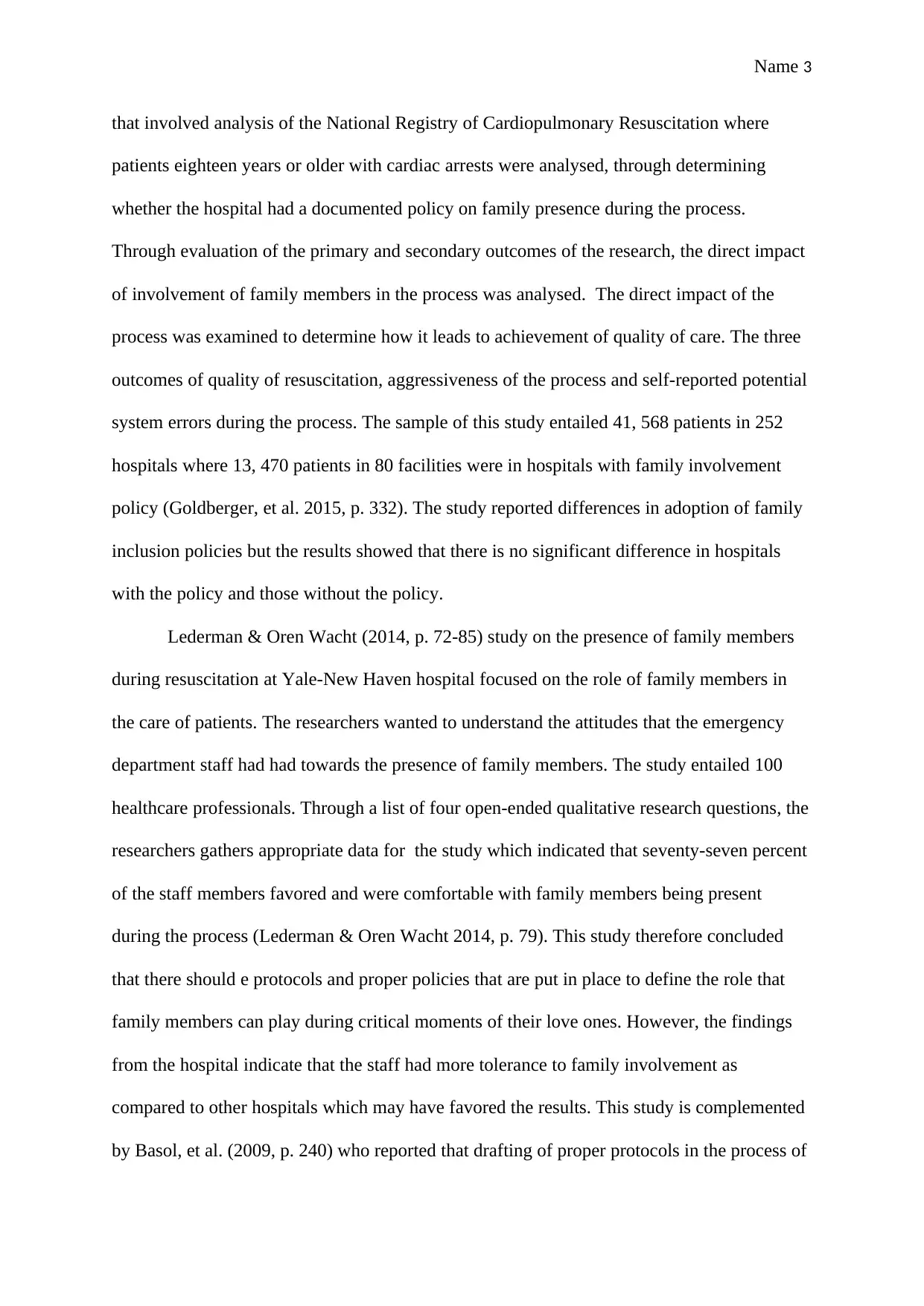
Name 3
that involved analysis of the National Registry of Cardiopulmonary Resuscitation where
patients eighteen years or older with cardiac arrests were analysed, through determining
whether the hospital had a documented policy on family presence during the process.
Through evaluation of the primary and secondary outcomes of the research, the direct impact
of involvement of family members in the process was analysed. The direct impact of the
process was examined to determine how it leads to achievement of quality of care. The three
outcomes of quality of resuscitation, aggressiveness of the process and self-reported potential
system errors during the process. The sample of this study entailed 41, 568 patients in 252
hospitals where 13, 470 patients in 80 facilities were in hospitals with family involvement
policy (Goldberger, et al. 2015, p. 332). The study reported differences in adoption of family
inclusion policies but the results showed that there is no significant difference in hospitals
with the policy and those without the policy.
Lederman & Oren Wacht (2014, p. 72-85) study on the presence of family members
during resuscitation at Yale-New Haven hospital focused on the role of family members in
the care of patients. The researchers wanted to understand the attitudes that the emergency
department staff had had towards the presence of family members. The study entailed 100
healthcare professionals. Through a list of four open-ended qualitative research questions, the
researchers gathers appropriate data for the study which indicated that seventy-seven percent
of the staff members favored and were comfortable with family members being present
during the process (Lederman & Oren Wacht 2014, p. 79). This study therefore concluded
that there should e protocols and proper policies that are put in place to define the role that
family members can play during critical moments of their love ones. However, the findings
from the hospital indicate that the staff had more tolerance to family involvement as
compared to other hospitals which may have favored the results. This study is complemented
by Basol, et al. (2009, p. 240) who reported that drafting of proper protocols in the process of
that involved analysis of the National Registry of Cardiopulmonary Resuscitation where
patients eighteen years or older with cardiac arrests were analysed, through determining
whether the hospital had a documented policy on family presence during the process.
Through evaluation of the primary and secondary outcomes of the research, the direct impact
of involvement of family members in the process was analysed. The direct impact of the
process was examined to determine how it leads to achievement of quality of care. The three
outcomes of quality of resuscitation, aggressiveness of the process and self-reported potential
system errors during the process. The sample of this study entailed 41, 568 patients in 252
hospitals where 13, 470 patients in 80 facilities were in hospitals with family involvement
policy (Goldberger, et al. 2015, p. 332). The study reported differences in adoption of family
inclusion policies but the results showed that there is no significant difference in hospitals
with the policy and those without the policy.
Lederman & Oren Wacht (2014, p. 72-85) study on the presence of family members
during resuscitation at Yale-New Haven hospital focused on the role of family members in
the care of patients. The researchers wanted to understand the attitudes that the emergency
department staff had had towards the presence of family members. The study entailed 100
healthcare professionals. Through a list of four open-ended qualitative research questions, the
researchers gathers appropriate data for the study which indicated that seventy-seven percent
of the staff members favored and were comfortable with family members being present
during the process (Lederman & Oren Wacht 2014, p. 79). This study therefore concluded
that there should e protocols and proper policies that are put in place to define the role that
family members can play during critical moments of their love ones. However, the findings
from the hospital indicate that the staff had more tolerance to family involvement as
compared to other hospitals which may have favored the results. This study is complemented
by Basol, et al. (2009, p. 240) who reported that drafting of proper protocols in the process of
⊘ This is a preview!⊘
Do you want full access?
Subscribe today to unlock all pages.

Trusted by 1+ million students worldwide
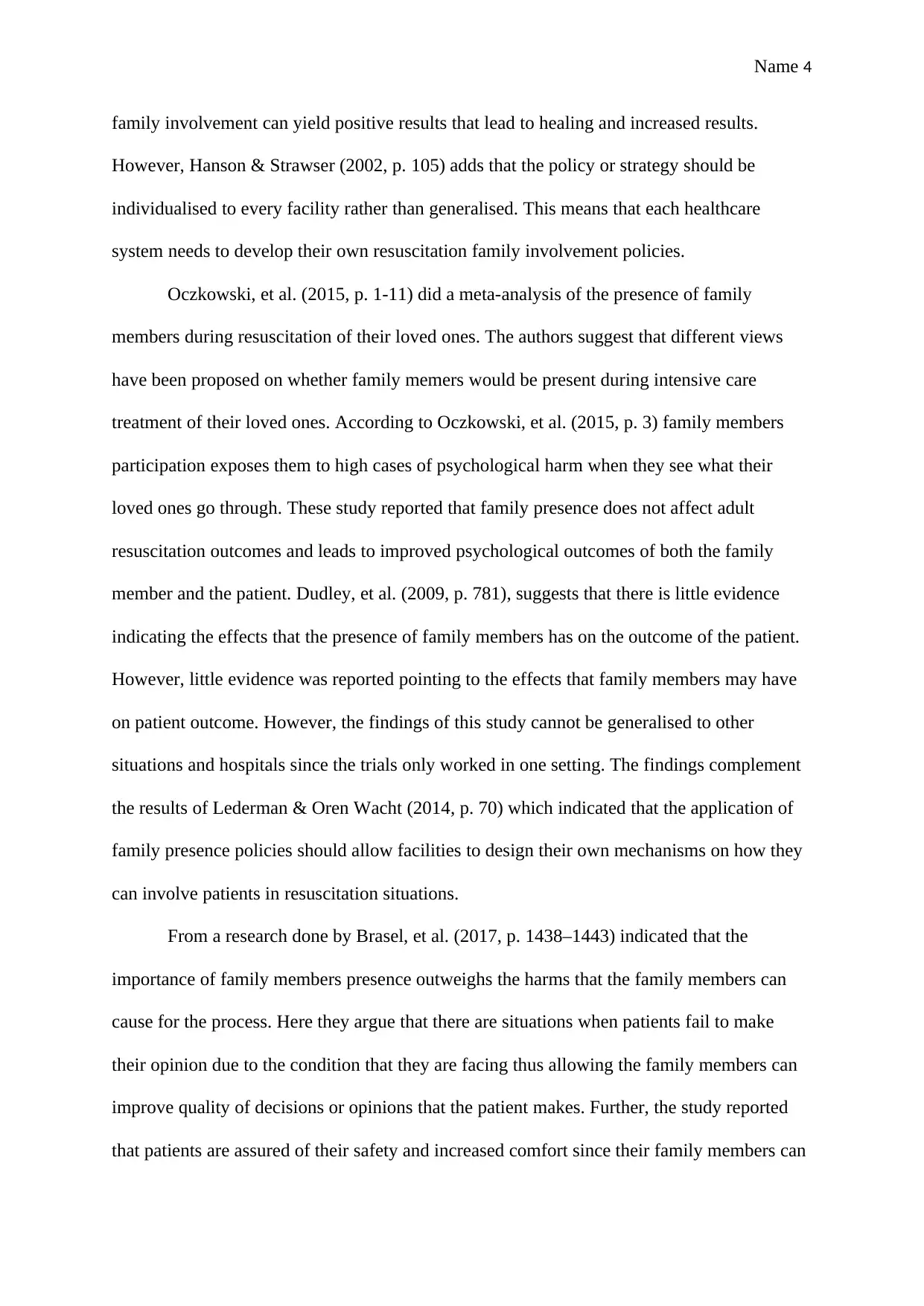
Name 4
family involvement can yield positive results that lead to healing and increased results.
However, Hanson & Strawser (2002, p. 105) adds that the policy or strategy should be
individualised to every facility rather than generalised. This means that each healthcare
system needs to develop their own resuscitation family involvement policies.
Oczkowski, et al. (2015, p. 1-11) did a meta-analysis of the presence of family
members during resuscitation of their loved ones. The authors suggest that different views
have been proposed on whether family memers would be present during intensive care
treatment of their loved ones. According to Oczkowski, et al. (2015, p. 3) family members
participation exposes them to high cases of psychological harm when they see what their
loved ones go through. These study reported that family presence does not affect adult
resuscitation outcomes and leads to improved psychological outcomes of both the family
member and the patient. Dudley, et al. (2009, p. 781), suggests that there is little evidence
indicating the effects that the presence of family members has on the outcome of the patient.
However, little evidence was reported pointing to the effects that family members may have
on patient outcome. However, the findings of this study cannot be generalised to other
situations and hospitals since the trials only worked in one setting. The findings complement
the results of Lederman & Oren Wacht (2014, p. 70) which indicated that the application of
family presence policies should allow facilities to design their own mechanisms on how they
can involve patients in resuscitation situations.
From a research done by Brasel, et al. (2017, p. 1438–1443) indicated that the
importance of family members presence outweighs the harms that the family members can
cause for the process. Here they argue that there are situations when patients fail to make
their opinion due to the condition that they are facing thus allowing the family members can
improve quality of decisions or opinions that the patient makes. Further, the study reported
that patients are assured of their safety and increased comfort since their family members can
family involvement can yield positive results that lead to healing and increased results.
However, Hanson & Strawser (2002, p. 105) adds that the policy or strategy should be
individualised to every facility rather than generalised. This means that each healthcare
system needs to develop their own resuscitation family involvement policies.
Oczkowski, et al. (2015, p. 1-11) did a meta-analysis of the presence of family
members during resuscitation of their loved ones. The authors suggest that different views
have been proposed on whether family memers would be present during intensive care
treatment of their loved ones. According to Oczkowski, et al. (2015, p. 3) family members
participation exposes them to high cases of psychological harm when they see what their
loved ones go through. These study reported that family presence does not affect adult
resuscitation outcomes and leads to improved psychological outcomes of both the family
member and the patient. Dudley, et al. (2009, p. 781), suggests that there is little evidence
indicating the effects that the presence of family members has on the outcome of the patient.
However, little evidence was reported pointing to the effects that family members may have
on patient outcome. However, the findings of this study cannot be generalised to other
situations and hospitals since the trials only worked in one setting. The findings complement
the results of Lederman & Oren Wacht (2014, p. 70) which indicated that the application of
family presence policies should allow facilities to design their own mechanisms on how they
can involve patients in resuscitation situations.
From a research done by Brasel, et al. (2017, p. 1438–1443) indicated that the
importance of family members presence outweighs the harms that the family members can
cause for the process. Here they argue that there are situations when patients fail to make
their opinion due to the condition that they are facing thus allowing the family members can
improve quality of decisions or opinions that the patient makes. Further, the study reported
that patients are assured of their safety and increased comfort since their family members can
Paraphrase This Document
Need a fresh take? Get an instant paraphrase of this document with our AI Paraphraser
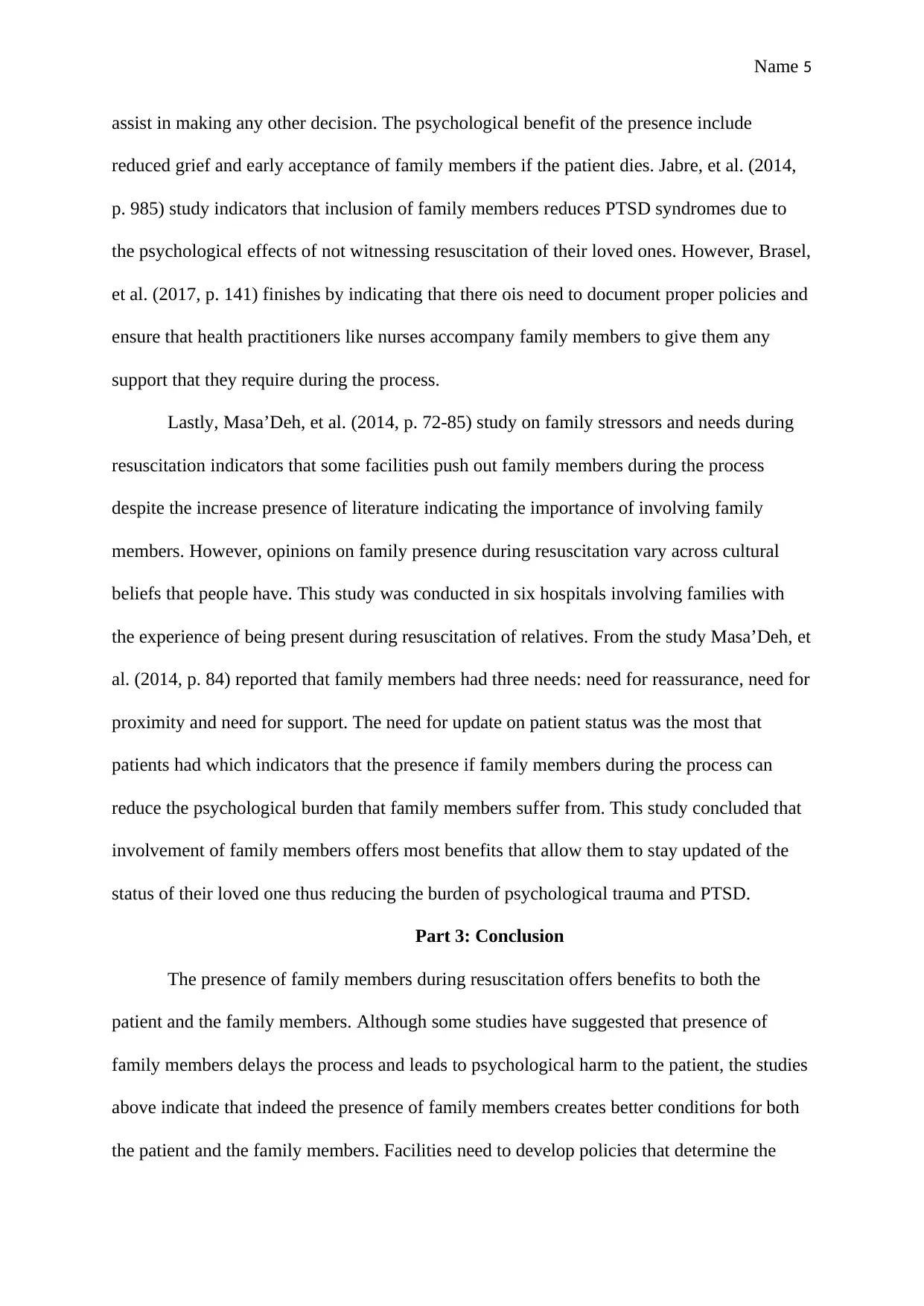
Name 5
assist in making any other decision. The psychological benefit of the presence include
reduced grief and early acceptance of family members if the patient dies. Jabre, et al. (2014,
p. 985) study indicators that inclusion of family members reduces PTSD syndromes due to
the psychological effects of not witnessing resuscitation of their loved ones. However, Brasel,
et al. (2017, p. 141) finishes by indicating that there ois need to document proper policies and
ensure that health practitioners like nurses accompany family members to give them any
support that they require during the process.
Lastly, Masa’Deh, et al. (2014, p. 72-85) study on family stressors and needs during
resuscitation indicators that some facilities push out family members during the process
despite the increase presence of literature indicating the importance of involving family
members. However, opinions on family presence during resuscitation vary across cultural
beliefs that people have. This study was conducted in six hospitals involving families with
the experience of being present during resuscitation of relatives. From the study Masa’Deh, et
al. (2014, p. 84) reported that family members had three needs: need for reassurance, need for
proximity and need for support. The need for update on patient status was the most that
patients had which indicators that the presence if family members during the process can
reduce the psychological burden that family members suffer from. This study concluded that
involvement of family members offers most benefits that allow them to stay updated of the
status of their loved one thus reducing the burden of psychological trauma and PTSD.
Part 3: Conclusion
The presence of family members during resuscitation offers benefits to both the
patient and the family members. Although some studies have suggested that presence of
family members delays the process and leads to psychological harm to the patient, the studies
above indicate that indeed the presence of family members creates better conditions for both
the patient and the family members. Facilities need to develop policies that determine the
assist in making any other decision. The psychological benefit of the presence include
reduced grief and early acceptance of family members if the patient dies. Jabre, et al. (2014,
p. 985) study indicators that inclusion of family members reduces PTSD syndromes due to
the psychological effects of not witnessing resuscitation of their loved ones. However, Brasel,
et al. (2017, p. 141) finishes by indicating that there ois need to document proper policies and
ensure that health practitioners like nurses accompany family members to give them any
support that they require during the process.
Lastly, Masa’Deh, et al. (2014, p. 72-85) study on family stressors and needs during
resuscitation indicators that some facilities push out family members during the process
despite the increase presence of literature indicating the importance of involving family
members. However, opinions on family presence during resuscitation vary across cultural
beliefs that people have. This study was conducted in six hospitals involving families with
the experience of being present during resuscitation of relatives. From the study Masa’Deh, et
al. (2014, p. 84) reported that family members had three needs: need for reassurance, need for
proximity and need for support. The need for update on patient status was the most that
patients had which indicators that the presence if family members during the process can
reduce the psychological burden that family members suffer from. This study concluded that
involvement of family members offers most benefits that allow them to stay updated of the
status of their loved one thus reducing the burden of psychological trauma and PTSD.
Part 3: Conclusion
The presence of family members during resuscitation offers benefits to both the
patient and the family members. Although some studies have suggested that presence of
family members delays the process and leads to psychological harm to the patient, the studies
above indicate that indeed the presence of family members creates better conditions for both
the patient and the family members. Facilities need to develop policies that determine the

Name 6
way family members need to be involved in the process to increase the psychological benefits
of the process. Facilities that have established proper policies and offer support to family
members report increased outcomes and reduced psychological effects to family members
like PTSD.
way family members need to be involved in the process to increase the psychological benefits
of the process. Facilities that have established proper policies and offer support to family
members report increased outcomes and reduced psychological effects to family members
like PTSD.
⊘ This is a preview!⊘
Do you want full access?
Subscribe today to unlock all pages.

Trusted by 1+ million students worldwide
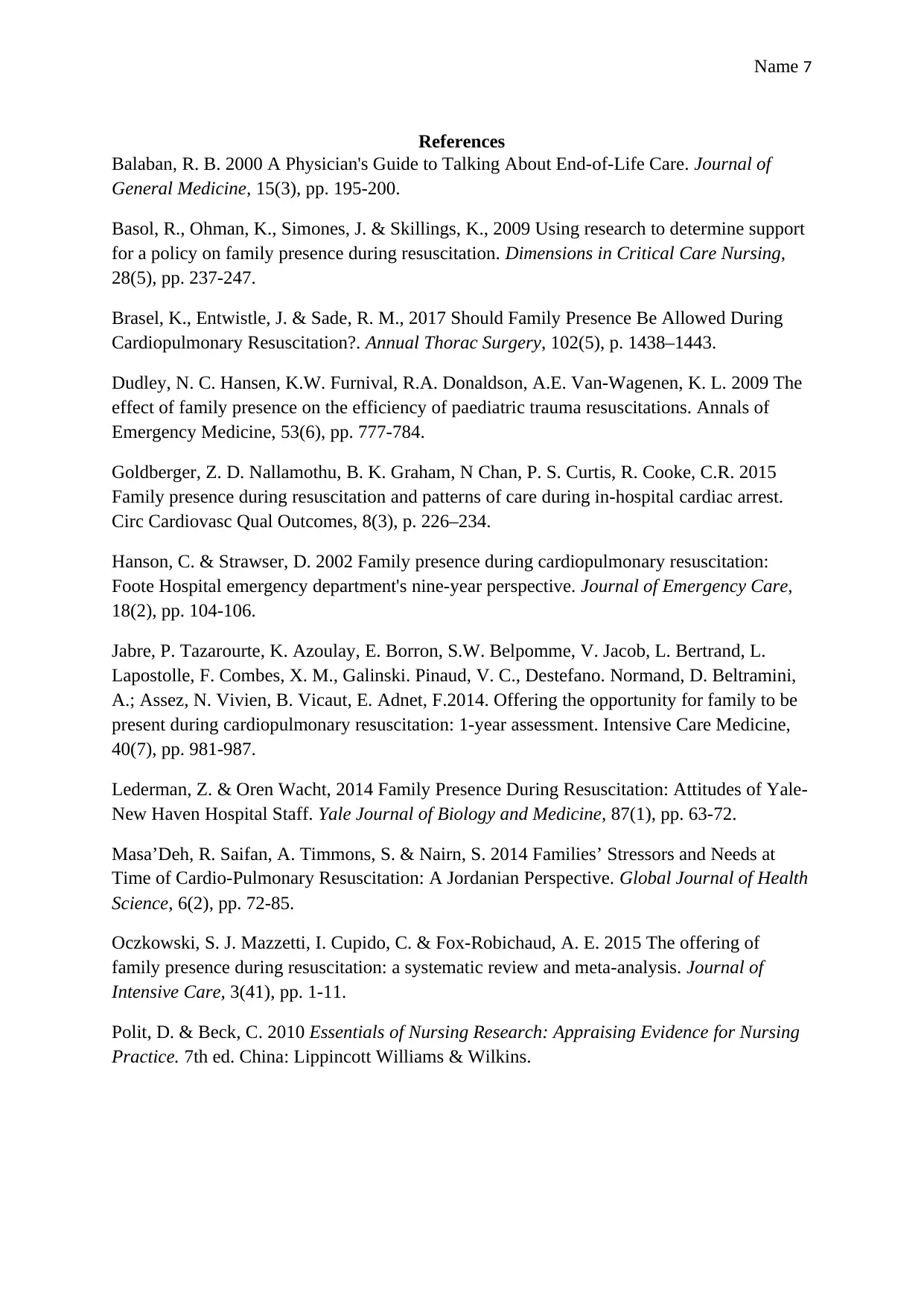
Name 7
References
Balaban, R. B. 2000 A Physician's Guide to Talking About End-of-Life Care. Journal of
General Medicine, 15(3), pp. 195-200.
Basol, R., Ohman, K., Simones, J. & Skillings, K., 2009 Using research to determine support
for a policy on family presence during resuscitation. Dimensions in Critical Care Nursing,
28(5), pp. 237-247.
Brasel, K., Entwistle, J. & Sade, R. M., 2017 Should Family Presence Be Allowed During
Cardiopulmonary Resuscitation?. Annual Thorac Surgery, 102(5), p. 1438–1443.
Dudley, N. C. Hansen, K.W. Furnival, R.A. Donaldson, A.E. Van-Wagenen, K. L. 2009 The
effect of family presence on the efficiency of paediatric trauma resuscitations. Annals of
Emergency Medicine, 53(6), pp. 777-784.
Goldberger, Z. D. Nallamothu, B. K. Graham, N Chan, P. S. Curtis, R. Cooke, C.R. 2015
Family presence during resuscitation and patterns of care during in-hospital cardiac arrest.
Circ Cardiovasc Qual Outcomes, 8(3), p. 226–234.
Hanson, C. & Strawser, D. 2002 Family presence during cardiopulmonary resuscitation:
Foote Hospital emergency department's nine-year perspective. Journal of Emergency Care,
18(2), pp. 104-106.
Jabre, P. Tazarourte, K. Azoulay, E. Borron, S.W. Belpomme, V. Jacob, L. Bertrand, L.
Lapostolle, F. Combes, X. M., Galinski. Pinaud, V. C., Destefano. Normand, D. Beltramini,
A.; Assez, N. Vivien, B. Vicaut, E. Adnet, F.2014. Offering the opportunity for family to be
present during cardiopulmonary resuscitation: 1-year assessment. Intensive Care Medicine,
40(7), pp. 981-987.
Lederman, Z. & Oren Wacht, 2014 Family Presence During Resuscitation: Attitudes of Yale-
New Haven Hospital Staff. Yale Journal of Biology and Medicine, 87(1), pp. 63-72.
Masa’Deh, R. Saifan, A. Timmons, S. & Nairn, S. 2014 Families’ Stressors and Needs at
Time of Cardio-Pulmonary Resuscitation: A Jordanian Perspective. Global Journal of Health
Science, 6(2), pp. 72-85.
Oczkowski, S. J. Mazzetti, I. Cupido, C. & Fox-Robichaud, A. E. 2015 The offering of
family presence during resuscitation: a systematic review and meta-analysis. Journal of
Intensive Care, 3(41), pp. 1-11.
Polit, D. & Beck, C. 2010 Essentials of Nursing Research: Appraising Evidence for Nursing
Practice. 7th ed. China: Lippincott Williams & Wilkins.
References
Balaban, R. B. 2000 A Physician's Guide to Talking About End-of-Life Care. Journal of
General Medicine, 15(3), pp. 195-200.
Basol, R., Ohman, K., Simones, J. & Skillings, K., 2009 Using research to determine support
for a policy on family presence during resuscitation. Dimensions in Critical Care Nursing,
28(5), pp. 237-247.
Brasel, K., Entwistle, J. & Sade, R. M., 2017 Should Family Presence Be Allowed During
Cardiopulmonary Resuscitation?. Annual Thorac Surgery, 102(5), p. 1438–1443.
Dudley, N. C. Hansen, K.W. Furnival, R.A. Donaldson, A.E. Van-Wagenen, K. L. 2009 The
effect of family presence on the efficiency of paediatric trauma resuscitations. Annals of
Emergency Medicine, 53(6), pp. 777-784.
Goldberger, Z. D. Nallamothu, B. K. Graham, N Chan, P. S. Curtis, R. Cooke, C.R. 2015
Family presence during resuscitation and patterns of care during in-hospital cardiac arrest.
Circ Cardiovasc Qual Outcomes, 8(3), p. 226–234.
Hanson, C. & Strawser, D. 2002 Family presence during cardiopulmonary resuscitation:
Foote Hospital emergency department's nine-year perspective. Journal of Emergency Care,
18(2), pp. 104-106.
Jabre, P. Tazarourte, K. Azoulay, E. Borron, S.W. Belpomme, V. Jacob, L. Bertrand, L.
Lapostolle, F. Combes, X. M., Galinski. Pinaud, V. C., Destefano. Normand, D. Beltramini,
A.; Assez, N. Vivien, B. Vicaut, E. Adnet, F.2014. Offering the opportunity for family to be
present during cardiopulmonary resuscitation: 1-year assessment. Intensive Care Medicine,
40(7), pp. 981-987.
Lederman, Z. & Oren Wacht, 2014 Family Presence During Resuscitation: Attitudes of Yale-
New Haven Hospital Staff. Yale Journal of Biology and Medicine, 87(1), pp. 63-72.
Masa’Deh, R. Saifan, A. Timmons, S. & Nairn, S. 2014 Families’ Stressors and Needs at
Time of Cardio-Pulmonary Resuscitation: A Jordanian Perspective. Global Journal of Health
Science, 6(2), pp. 72-85.
Oczkowski, S. J. Mazzetti, I. Cupido, C. & Fox-Robichaud, A. E. 2015 The offering of
family presence during resuscitation: a systematic review and meta-analysis. Journal of
Intensive Care, 3(41), pp. 1-11.
Polit, D. & Beck, C. 2010 Essentials of Nursing Research: Appraising Evidence for Nursing
Practice. 7th ed. China: Lippincott Williams & Wilkins.
1 out of 7
Related Documents
Your All-in-One AI-Powered Toolkit for Academic Success.
+13062052269
info@desklib.com
Available 24*7 on WhatsApp / Email
![[object Object]](/_next/static/media/star-bottom.7253800d.svg)
Unlock your academic potential
Copyright © 2020–2025 A2Z Services. All Rights Reserved. Developed and managed by ZUCOL.





